WORLD CLASS COACHING
4-2-3-1 Defending
By Luca Bertolini
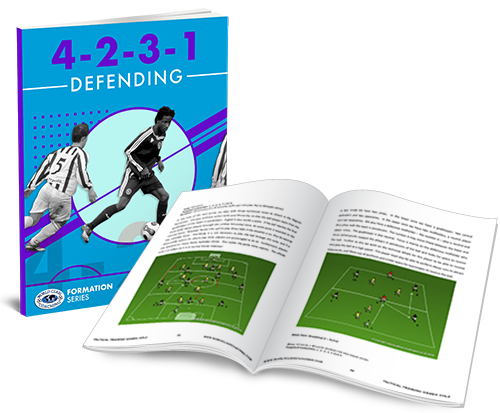
Table of Contents
PART TWO
Basic Principles of Play and Responsibilities Without the Ball - Part 2
Basic Principles of Play and Responsibilities Without the Ball - Part 2
Delay – The defender(s) forces the attacking team to slow down the rhythm so that the defense phase can be organized, if it’s not possible an immediate recovery of the possession. It's very important to not being overcome easily in this phase, as the time for the team to organize the defense shape is shortened. The team without possession is supposed to be a bit closer to the own goal, inside the defending half (back line, the less) and a compact positioning is absolutely needed to prevent the opposition from being dangerous.
In this example, David Silva attempts a long pass toward Aguero and behind the opposition defense line and Sterling moves forward to be a support for the center striker. Man City is positioned to make the field quite big, with Zichenko providing width on the left and Mahrez on the right flank.
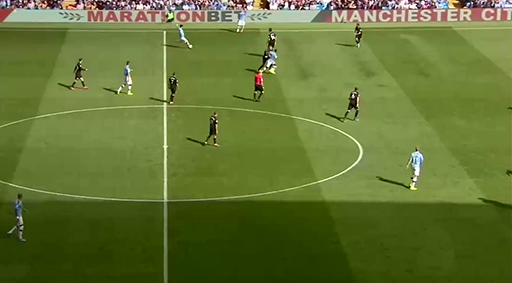
At this point of Man City possession phases, the team is always positioned wide on the field, but the main differences are the wrong long pass and the missing passing combinations that usually allow to overload the center spaces; when the opposition defender controls the ball, there are gaps that could be exploited among the City players and sectors’ lines.
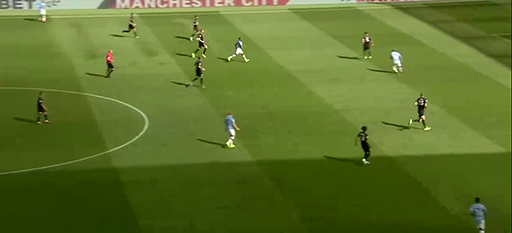
The opposition has a huge numerical advantage near the ball and the immediate Aguero and Sterling pressure actions against the ball carrier can’t be effective; a 1+3 v 2 can be noticed very well in the image up here.
The center advance midfielder De Bruyne and the right winger Mahrez are too far away to help the pressure phase.
The center holding midfielders have the same issue, as they are too backward to make the pitch smaller and to shorten the space running forward.
De Bruyne and Mahrez can recognize the situation immediately and they start to retreat their positions, as the opposition second ball carrier can receive, turn and dribble forward.
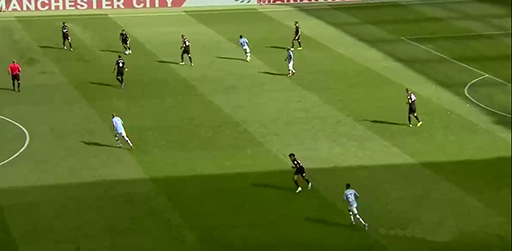
When the attacking move of the opposition arrives in the middle third, David Silva’s individual pressure phase is very important, as it allows Man City to shape the back four line properly, creating numerical advantage at the back (3+2 v 2 and De Bruyne who is retreating back) and not too deep toward the goal, delaying the rhythm of the ball carrier and forcing him backward
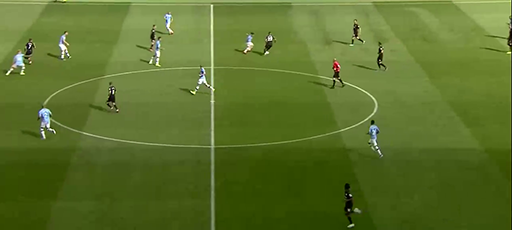
The advanced midfielder David Silva delays the opposition possession, while the holding midfielders position themselves in front of the back four.
The center backs, Otamendi and Laporte can double team the center forward, the left holding midfielder can control the right attacker together with the left fullback Zichenko and the right fullback Walker has the time to cover the space in front of the third opponents on the right.
The 1 v 1 against the ball carrier allowed Man City to get narrow at the back, to create safe 2 v 1 duels along the last defending lines and a general numerical advantage (6 v 3) behind the ball line.
This is another point of strength for 1-4-2-3-1; even when one fullback is out of position, when one of the center midfielder has pushed up during the possession phases, when the team loses the ball in the middle third, there are often 3+1 defending players who can provide balance at the back, allowing the teammate to retreat back and shape the defense formation in a correct manner and quickly enough.
Note: it’s important to understand that Guardiola’s Man City positioned the player in a different way when the possession phase if being developed inside the final third, when pressure and defensive positional play are fundamental.
Eventually the opposition is forced to play backward and to build up from the back again, as the only really unmarked teammate is the left wide winger along the opposite side.
As Aguero and Sterling area ready to press the ball carrier, he passes back again quickly to the center backs to answer to the pressure trace against him.
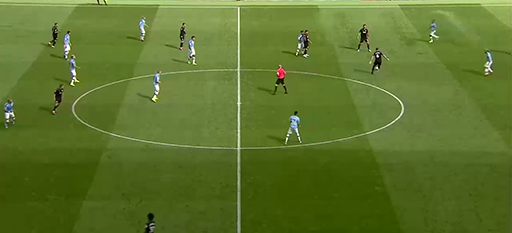
In this situation, Manchester City has lost yards on the field, being forced to retreat the positions backward, but the defensive shape ensures safety and control of the space and of the opponents at the back.
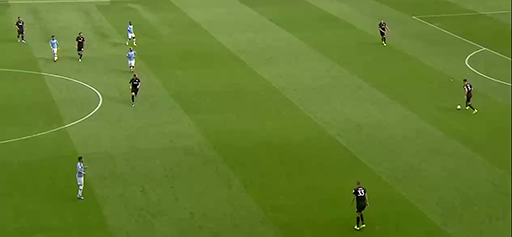
The opposition center backs can play freely but all the receivers of a forward pass are potentially under pressure; Aguero is tracking the holding midfielder, the right winger Mahrez can press the left fullback easily, David Silva is marking the second midfielder behind Aguero and Sterling can retreat back few yards to counter the opposition right fullback.
This sequence is a good example of delay action, when counter-pressing is not immediately possible and the pressure phase is not effective.
Depth – The immediate organization behind the pressuring defender(s), where all the other predetermined players should recover into defensive positions to support the teammates in case they are beaten. This is what is called "providing defensive cover".

In this first example, Manchester City opposition has been able to build up from the back, overcoming the pressure of the advanced midfielder and of the forward (De Bruyne and Aguero); the depth is covered inside the lower part of the final third, creating numerical advantage behind them as follow:
1. The right winger Mahrez counters the opposition left wingback, screening any passing path toward the center and trying to force him down the wing
2. The center midfielders Rodri and David Silva cover the opposition holding midfielder in a 2 v 1 duel that closes any potential movement off the ball
3. The left advanced midfielder Sterling can track the second center midfielder easily
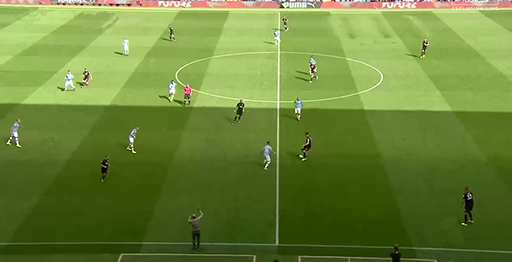
This second situation is about depth coverage behind a 1 v 1 duel area in the middle third:
1. Mahrez is countering 1 v 1 the opposition ball carrier along the middle third line on the right wing
2. Center forward Aguero has dropped back along the three advanced midfielders, David Silva and Sterling are marking 1 v 1 the nearest opponents, as well as Aguero may put pressure against the nearest passing option for the ball carrier
3. The center holding midfielders (De Bruyne and Rodri) are placed behind this “pressure line” and they are covering the back four (the right back Walker is out of the picture) shaping 1-4-2-4
4. The depth coverage in this situation is provided by center midfielders, who are preventing the opposition from playing through the center and toward the back line
5. The defending lines are very narrow to save the center depth on the field, leaving space along the flanks.
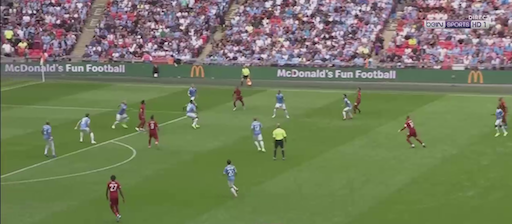
This third picture that is taken from last Manchester City – Liverpool, is about depth shows the coverage of the box and of the goal space to defend an open areal ball:
1. The back four line is very narrow on the left side and very close to the ball position
2. One center back (Otamendi) is looking for the ball, trying to anticipate the opposition attacker together with the holding midfielder Rodri and the second one moves to cover the depth space behind him inside the box; Sanè, who is positioned as second holding midfielder is very close to the teammate and he can support his action quickly
3. Body positioning of the three advanced midfielders (Bernardo Silva on the right, De Bruyne in the center of the space and David Silva on the left), who are retreating back toward the ball and teammates can be useful to save any deep passing attempt.
4. In case of Liverpool possession would be very difficult to find a path toward the goal and the only possible solution would be to switch the side or to play back to the center midfielder.
Balance – When the team overloads the area of the ball, defenders away from this space or in the opposite side of field must position themselves to cover the spaces (central areas or weak sides) to prevent penetrating runs, where the opponents may receive a pass.
Following the previous image and the development of the situation, after depth coverage to save the areal ball, Man City shows us a team defending balance action to save the opposite side.
After winning possession, Bernardo Silva kicks the ball away to allow the team to advance on the field from the first third…
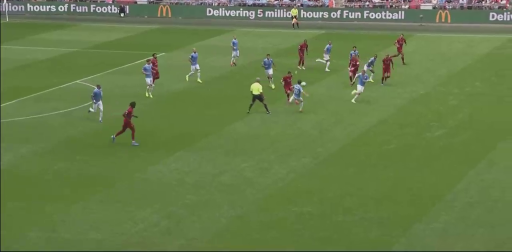
…but the advanced teammates are on late against the opposition back line that is positioned high on the field; Liverpool wins the possession back. De Bruyne attempts a forward pass, in behind the defense line for Sterling, but the pass is intercepted.
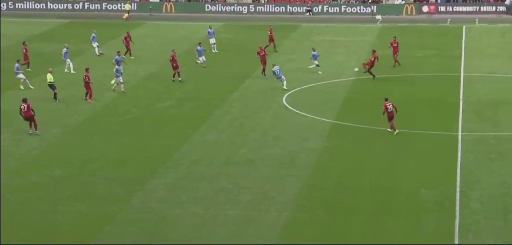
While pushing up the field, Man City starts to spread out the formation shape along the width of the field to cover the opposite flank that is, as we just analyzed in “depth section”, one of two only possible solutions to keep possession.
The center backs (Stone and Otamendi) and the left fullback Zichenko stop their forward run not to open chances for through or long passes in behind.
The middle line slows down the rhythm, staying positioned close to the back line; Sanè, David Silva, Rodri and Bernardo Silva shape a 1-4-4-2 formation is then shaped in the final third together with the back line and the last two advanced midfielders.
This way, Man City remains compact at the back, confirming once again as balance and compactness are very linked principles of play.
The only space available for the opposition to develop the possession phase is along a weak area far away from the box and the goal.
Liverpool switches the side as quickly as possible on the left inside the middle third and the fullback is free to receive wide.
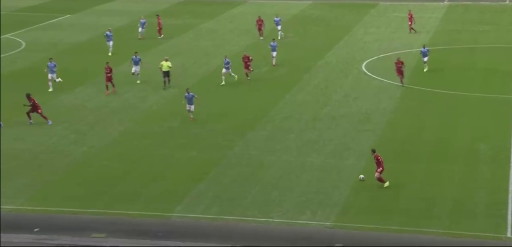
Man City increases its spreading out action, as Bernardo Silva is very fast at covering the space along the right flank, De Bruyne and David Silva can double team the opposition holding midfielder and Sanè is on the nearest opponents on the opposite flank that was overload before. A 1-4-1-4-1 defense shape is then created, where the holding midfielder covers the center backs.
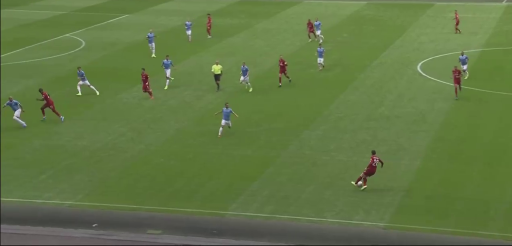
The right fullback Walker and the right center back Stone track the run off the ball of the left winger, Rodri tracks the center forwards who drops back and the left center back Otamendi and the left fullback Zichenko can mark the right winger and cover the space in front of him.
The only option for the fullback in possession is to dribble up the field, but the risk would be to find all the passing options closed.
Liverpool is forced to play out from the back again in a low risk defense situation for Manchester City.
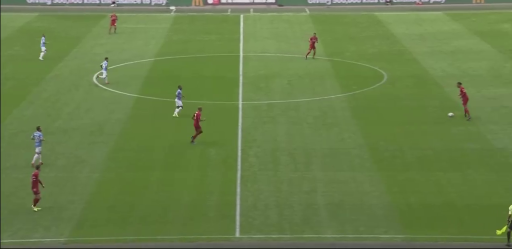
In this defending action, balance has multiple meanings:
1. Shift across the field to cover the weak side and force the opposition backward
2. Create numerical advantage situations against the advanced opposition passing options
3. Save the 18 y box and the goal as far away as possible
As we have already found out, balance means to cover the space of the defense shape from this side of the pressure area.
This second sequence, where balance actions are very clear, is very interesting because it starts from a compact defense of the depth situations at the back.
Manchester City is shaped in a very narrow 1-4-2-3-1 inside the right final third.
• Otamendi and Laporte are the center backs, Walker and Zichenko the right and left fullbacks
• Rodri and David Silva act as center holding midfielders
• Sterling on the left, De Bruyne in the center, Mahrez on the right are the advanced midfielders
• Aguero is the center forward.
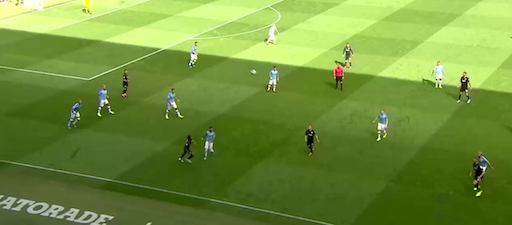
The ball has been kicked out from the condensed area of the field were defenders and lower midfielders have the numerical advantage (6 v 2), but the advanced midfielders and the center forward are involved in multiple 1 v 1 duels (4 v 4).
The narrow positioning of City defense shape ensure a general numerical advantage throughout the right side of the own half field; an 8 v 6 duel can be noticed inside the lower right quarter of the field.
Mahrez can mark the nearest potential receiver of the throw-in, left fullback Zichenko and left winger Sterling can press their opponents easily and with a short move, Rodri can press the third opposition attacker in front of him; the only opposition free player is turned toward his own goal and he can be pressed by De Bruyne if he receives.
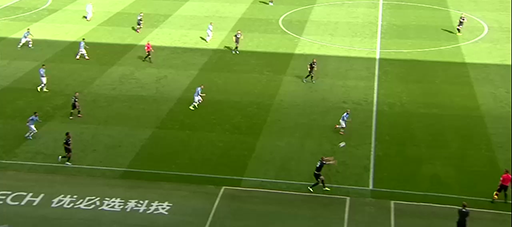
The opposition throws the ball in passing backward, to switch the side quickly on the right attacking flank, to play out from the overload area.
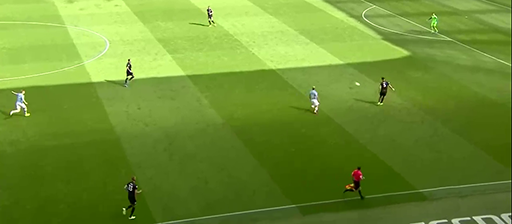
The center forward Aguero forces the opposition center back to pass to the second one (or goalkeeper could have been another potential solution for the ball carrier); meanwhile, Man City runs up through the field quickly.
De Bruyne is starting to shift across the field to act as second pressing player.
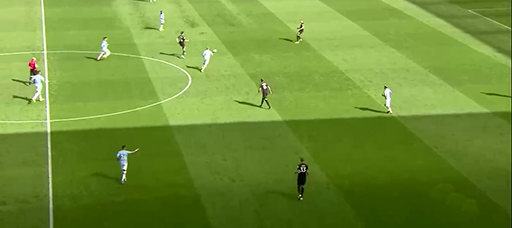
The opposition center backs invite the pressure of the Citizens, allowing them to run up the field and to place six players inside the attacking half
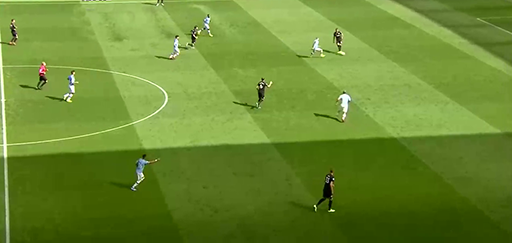
De Bruyne becomes the most advanced player of the team, Aguero is on the right shifting across, David Silva and Sterling are running forward too, at the back of the pressing teammates to provide balance at a first stage.
Behind them Mahrez and Rodri are providing balance as well in the middle third.

Aguero, De Bruyne and Sterling are placed high in a 3 v 3 duel in front of the opposition box, David Silva is right behind them and he tracks the long pass toward the left defending side, providing balance along the left defending flank.
Rodri is placed in the center and Mahrez on the center right to provide balance again.
The opposition center back is forced to play out wide quickly, creating an open ball situation with an aerial pass.
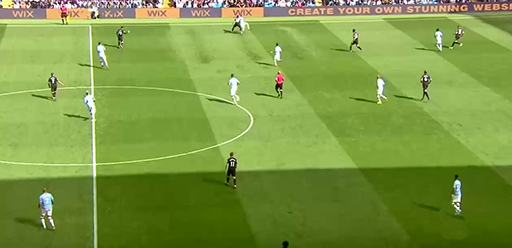
Even if the possession is not recovered, the opposition has lost yards on the field and City could advance thanks to combination of pressure and coverage inside the attacking half between middle third and attacking lines.
Compactness – While the defending team is retreating back toward the goal to organize the defense phase, time and space for the opponent must be limited, concentrating their defense all around the area of the ball. Defenders also recover centrally towards their goal in order to limit the opponents’ ability to directly attack the goal.

In this example, De Bruyne attempts a pass in behind the opposition midfield line on the run of Gundogan, who is trying to exploit the wrong body positioning of the center right midfielder (the back four defense line is place just inside the 18 y box)…
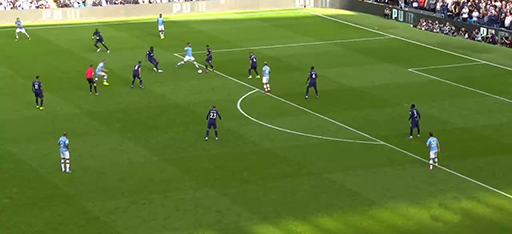
…the right fullback is able to anticipate Gundogan and he can play forward to launch a fast transition to attack.

The left fullback Zichenko, the holding midfielder Rodri and the inverted fullback Walker ensure compactness at the back of Man City usual attacking line of five.
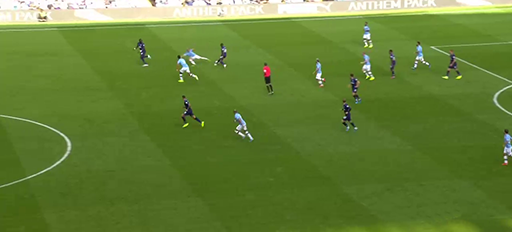
In this situation, Zichenko attempts to counter the ball carrier with a wrong timing and making a wrong tactical choice, as he frees the direct opponent in the 1+1 v 2 duel (himself + Rodri, who is retreating to track the counter attacking move; a forward pass becomes very easy then.
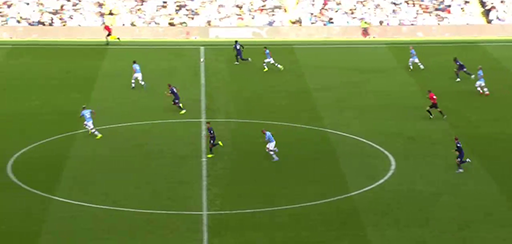
A space along the flank is created for the receiver, who can dribble the ball up, but Manchester City center backs (Laporte and Otamendi) are properly positioned to recover the space and to shift wide toward him.
The prior Manchester City attacking line of five forced the opposition to place seven players inside the first third and this makes the counter attacking attempt isolated.
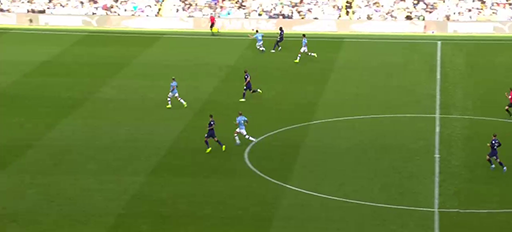
Laporte is able to counter the ball carrier, exploiting the defending action of Rodri, who forced him along the sideline. Otamendi cover the depth and Walker is tracking the run of the third opposition attacker.

The counter attacking move is then easily blocked, kicking the ball out of play.
Control and Restraint – The players should pay attention to play under control, when challenging for the ball, to not make poorly timed or off-balanced attempts; otherwise, they should restrain from tackling until they are sure to recover the possession.
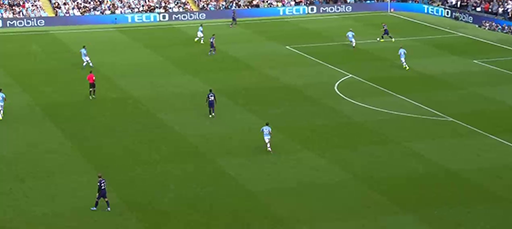
In this situation, Aguero is pressing the opposition ball carrier inside the box and Sterling is pushing high to counter the nearest passing option out wide, as Aguero is also screening the forward option out of the box. Bernardo Silva, the right winger, is shifting across the center to force the potential direction of play of the opponent in front of him.
Gundogan realizes he has to cover the space behind the pressure area and he doesn’t push higher, so he can control the space behind the pressure and ball area.
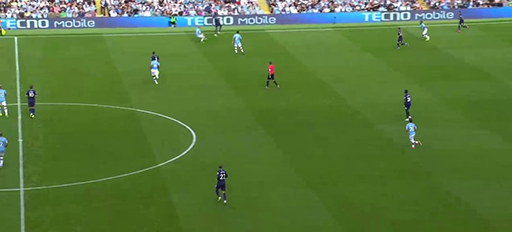
The attacking move is countered directly by the left fullback Zichenko, while the opponent is trying to control an aerial pass; Rodri is tracking his direct opponent and Otamendi and Walker ensure numerical advantage against the opposition center forward.
The opposition move is controlled through numerical advantage around the ball and against the center forward.
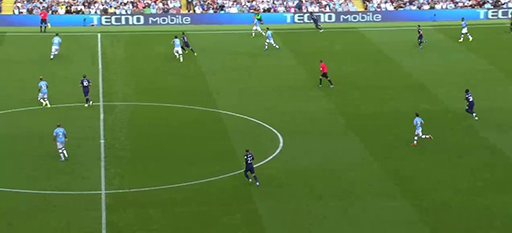
Despite the opposition is able to attempt to play forward again, Rodri is man marking the potential ball carrier, Laporte is closing the space down the wing and Otamendi is checking the center forward; Gundogan and Zichenko are retreating their positions to help the pressure phase.
In this second example Manchester City is acting positional pressure against the opposition building up from the back sequence.
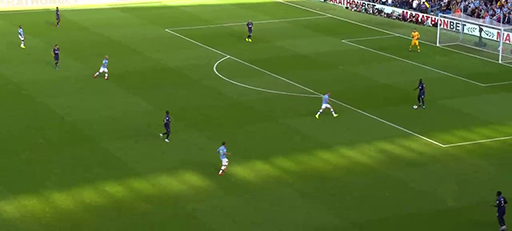
De Bruyne acts as center forward and Sterling on the left, Aguero, who exchanged his position with the center advanced midfielder, in the center and Bernardo Silva on the right are screening the chances to play up the field for the ball carrier.
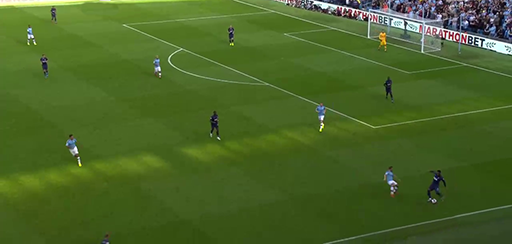
The opposition fullback is forced to receive a difficult wide pass and to pass forward quickly because of Bernardo Silva pressure; Rodri, the holding midfielder is retreating a little back to check the area behind the pressure and ball area.
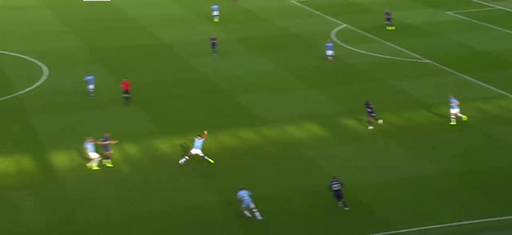
Thanks to this backward movement, he can intercept the pass toward the opposition second striker…
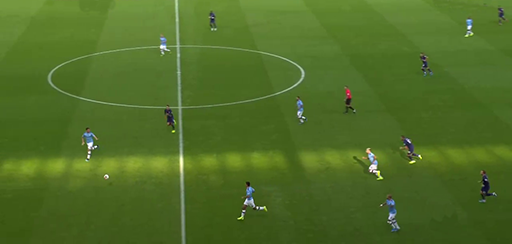
…and City can win the possession back.


